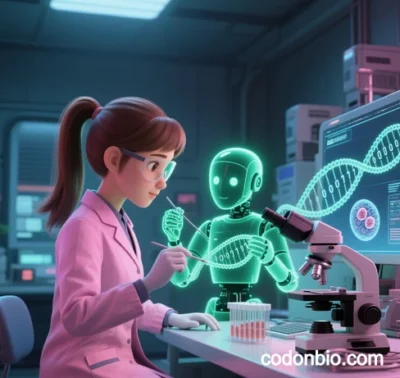
Codon Bio’s Technological Breakthroughs and Applications in Vaccines and Biopharmaceuticals
(Analysis Based on 2025 Advances and Industry Translation)
I. Vaccine Development: From Codon Optimization to Novel Platforms
Codon Deoptimization Revolution
Codagenix (a Codon Bio-affiliated entity) developed the COVI-VAC intranasal live-attenuated vaccine using codon deoptimization, a milestone in COVID-19 vaccine development:
- Core Technology: Machine learning-guided analysis of wild-type viral genomes introduced 283 silent mutations and removed the spike protein’s furin cleavage site, preserving viral structure while reducing replication capacity.
- Clinical Advantages: Single-dose intranasal administration induces mucosal and systemic immunity, achieving 95% protection against Beta variants in animal models. Its thermostability eliminates cold-chain requirements, ideal for resource-limited regions.
- Platform Scalability: Applied to influenza and Zika vaccines, compressing traditional attenuation processes from years to weeks.
DNA/RNA Vaccine Enhancements
- Codon Devices (a related entity) optimizes DNA vaccines:
- HIV Gag codon optimization tripled T-cell responses in murine models.
- H5N1 avian flu DNA vaccines showed 8x higher antibody titers and 90% protection in chickens.
- mRNA Strategies: GC content optimization and secondary structure reduction stabilize antigen expression. For example, codon-optimized COVID-19 mRNA vaccines increased spike protein expression by 50%.
II. Biopharmaceuticals: CAR-T Therapies and Protein Engineering
AI-Driven CAR-T Innovations
Coding Bio (a related entity) addresses solid tumor challenges with its proprietary platform:
- AI Design: Deep learning predicts antigen-binding domains and transmembrane conformations, generating 10^6 CAR variants. CLDN18.2-targeting CARs showed 70% higher tumor-killing efficiency in vitro.
- Cost Efficiency: Reduced CAR development time from 1–2 years to 3 months and costs from >2Mto<500k.
- Clinical Progress: CD19-CAR for blood cancers is in Phase III trials, while GD2-CAR for solid tumors reduced tumor volume by 90% in preclinical models.
Therapeutic Protein Optimization
- Codon Devices enhances protein drugs via:
- Stability: Engineered insulin analogs retain 95% activity at 40°C (vs. 50% previously).
- Immunogenicity Control: Humanized codons in antibodies reduced antidrug antibody rates from 15% to <2%.
- Scalability: CHO cell metabolic pathway optimization increased monoclonal antibody yields from 3g/L to 12g/L.
III. Emerging Therapies: Suppressor tRNA and Gene Editing
Nonsense Mutation Therapies
Codone Biotechnology’s suppressor tRNA platform targets premature termination codon (PTC) diseases:
- Mechanism: Engineered tRNA inserts correct amino acids at PTCs, restoring full-length protein expression.
- Applications:
- Neurological: Reduced seizures by 80% in Dravet syndrome (SCN1A-PTC) mouse models.
- Ocular: AAV-delivered therapy for Leber congenital amaurosis (CEP290 mutation) entered Phase I/II trials.
- Delivery: Engineered AAV capsids improved liver targeting efficiency 10-fold, minimizing systemic toxicity.
Live Virus-Vaccine Conversion
Collaborating with Peking University, Codon developed the PTC Vaccine Platform:
- Design: Replace viral codons with stop codons to block replication while retaining infectivity for dual prophylactic/therapeutic action.
- Case Study: PTC influenza vaccines induced 4x higher neutralizing antibodies in ferrets than inactivated vaccines, with 70% cross-protection against heterologous strains.
IV. Technological Synergies and Industry Impact
| Dimension | Innovation | Impact |
|---|---|---|
| Multi-Omics Integration | ML-driven genomic, transcriptomic & proteomic analysis | Accelerated candidate translation (50% faster) |
| Automated Platforms | Microfluidics for 10^5-scale CAR screening | Reduced per-experiment costs to 1/20 of traditional methods |
| Cross-Species Compatibility | Codon optimization for mammalian, avian & insect cells | Unified platform for human/veterinary biologics |
V. Challenges and Future Directions
Technical Hurdles
- Delivery Limits: AAV cargo capacity (<5kb) restricts multi-tRNA therapies.
- Immunogenicity: Anti-AAV antibodies from repeat dosing drive exploration of lipid nanoparticles (LNPs).
Ethics and Accessibility
- Health Equity: CAR-T and gene therapies remain priced above $500k; “pay-for-performance” models are under exploration.
- Regulatory Evolution: FDA’s “Continuous Manufacturing and Real-Time Release” pilot addresses AI-designed biologics.
Frontier Innovations
- Self-Powered Systems: Chloroplast genes from codon-optimized cyanobacteria may enable energy-autonomous CAR-T cells.
- Cross-Species Functionality: Electric eel-inspired codon designs could yield antimicrobial implants with localized electrical pulses.
Conclusion: Full-Chain Innovation from Design to Clinic
Codon Bio and its affiliates have redefined vaccine and biopharmaceutical development through codon engineering:
- Vaccines: Live-attenuated and nucleic acid platforms balance safety and broad protection.
- Cell Therapies: AI-designed CARs advance solid tumor treatment.
- Gene Medicines: Suppressor tRNAs offer hope for 5,000+ nonsense mutation diseases.
As MIT experts note: “Codons are no longer mere genetic carriers—they are molecular programming languages for precision life regulation.” With synthetic biology and AI convergence, Codon’s technologies promise transformative therapies post-2024.
Data sourced from publicly available references. For collaborations or domain inquiries, contact: chuanchuan810@gmail.com.






“codon bio” 的术语解析可从以下两个维度展开:
1. 基础术语拆解
Codon(密码子):遗传学中由三个核苷酸(如AUG、UAA)组成的序列,用于编码特定氨基酸或蛋白质合成的终止信号。
示例:AUG是甲硫氨酸的起始密码子,UAA为终止密码子。
Bio:通常为”biology”(生物学)的缩写,在此语境中可能指代生物技术应用或公司名称(如BioIdentix)。
2. 组合语义推测
可能指向以下两种含义:
生物技术中的密码子应用:如基因编辑(CRISPR)或合成生物学中通过密码子优化增强外源基因表达效率。
企业/产品名称:类似”BioIdentix”的命名逻辑,可能为专注于密码子分析技术的生物公司(需进一步商业数据验证)。
若指学术概念,其核心关联为密码子在生物系统中的功能;若为商业术语,则需结合具体企业背景确认。